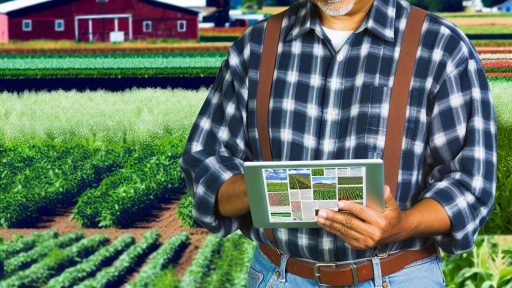Introduction to Soil Conservation
Importance of Soil Conservation
Soil conservation plays a vital role in maintaining land health.
Healthy soil contributes to the growth of nutritious crops.
It prevents soil erosion, ensuring longevity for agricultural lands.
Additionally, soil conservation enhances water retention capabilities.
This process supports sustainable agriculture and food security.
Furthermore, conservation practices promote biodiversity in ecosystems.
Benefits of Soil Conservation
Implementing soil conservation practices leads to numerous benefits.
One significant advantage is improved soil fertility.
Healthy soils retain nutrients, which boosts crop yields.
Moreover, conservation reduces the need for chemical fertilizers.
This reduction decreases the environmental impact of farming.
Soil conservation also helps in climate change mitigation.
Maintaining healthy soils enables carbon sequestration.
This process aids in controlling greenhouse gas emissions.
Overall, soil conservation is essential for a sustainable future.
Transform Your Agribusiness
Unlock your farm's potential with expert advice tailored to your needs. Get actionable steps that drive real results.
Get StartedKey Principles of Soil Conservation Practices
Understanding Soil Health
Healthy soil is the foundation of productive farming.
It supports plant growth and maintains ecological balance.
Moreover, healthy soil can retain nutrients and water effectively.
Reducing Soil Erosion
Erosion leads to significant loss of topsoil.
Implementing cover crops helps protect the soil surface.
Additionally, contour plowing can reduce water runoff.
Maintaining Soil Structure
Good soil structure enhances air and water movement.
Practices like reduced tillage preserve soil integrity.
Regular organic matter addition improves soil texture over time.
Enhancing Soil Fertility
Fertility influences crop yield and health.
Using natural fertilizers can boost nutrient levels sustainably.
Crop rotation allows for natural replenishment of soil nutrients.
Water Management Techniques
Effective water management is critical for soil conservation.
Practices such as terracing can minimize water runoff.
Rainwater harvesting ensures moisture availability for crops.
Promotion of Biodiversity
Diverse plant species improve soil stability and fertility.
Encouraging beneficial insects can enhance pest control naturally.
Additionally, a variety of plants can improve soil health.
Community Engagement and Education
Raising awareness promotes soil conservation efforts.
Community workshops can teach beneficial practices effectively.
Collaboration fosters local stewardship for soil health.
Types of Soil Erosion and Their Impacts
Water Erosion
Water erosion occurs when rain or melting snow displaces soil particles.
This type affects areas with limited vegetation cover.
It often leads to significant nutrient loss from the soil.
Showcase Your Farming Business
Publish your professional farming services profile on our blog for a one-time fee of $200 and reach a dedicated audience of farmers and agribusiness owners.
Publish Your ProfileAdditionally, it can result in sedimentation in nearby water bodies.
This sedimentation can harm aquatic ecosystems.
Wind Erosion
Wind erosion happens in dry, arid regions.
Strong winds detach and transport soil particles away.
This process can create dust storms that reduce air quality.
Moreover, it diminishes soil fertility in affected areas.
Farmers often struggle with reduced crop yields because of wind erosion.
Universal Erosion
Universal erosion involves the gradual wearing away of the land surface.
This can occur due to various natural processes over time.
It leads to the loss of productive land and disrupts ecosystems.
Farmers may face challenges in maintaining harvest yields.
Collectively, these erosive processes threaten global food security.
Gully Erosion
Gully erosion forms large, deep channels in the landscape.
This usually develops after intense rainfall events.
Such erosion can affect water drainage patterns significantly.
It also leads to serious challenges in land management.
Addressing gully erosion requires strategic interventions.
Soil Erosion Prevention Methods
Implementing cover crops can help mitigate erosion risks.
These crops protect the soil between harvests.
Furthermore, contour farming reduces water runoff effectively.
Terracing can also enhance water retention in sloped areas.
Education and community involvement are essential for successful prevention.
Delve into the Subject: Navigating Regulations Of Agricultural Conservation Programs
Regulatory Framework Governing Soil Conservation
Importance of Regulation
Soil conservation regulations protect valuable soil resources.
They ensure sustainable land use practices across various sectors.
These rules aim to prevent soil erosion and degradation.
Moreover, they support agricultural productivity and environmental health.
Key Regulatory Bodies
Several agencies oversee soil conservation regulations at different levels.
The Environmental Protection Agency (EPA) plays a crucial role in this area.
Additionally, local agricultural extension offices provide valuable guidance.
State departments of agriculture also implement specific conservation programs.
Legislation Impacting Soil Conservation
Numerous laws promote soil conservation practices and methods.
The Soil Conservation Act establishes fundamental principles for soil protection.
Furthermore, the Clean Water Act influences how land is managed near waterways.
Both laws emphasize reducing erosion and improving overall soil health.
Strategies Mandated by Regulations
Regulations require various strategies to conserve soil effectively.
- Implementing crop rotation to enhance soil structure.
- Utilizing cover crops to maintain soil cover during off-seasons.
- Adopting no-till farming practices to reduce soil disturbance.
- Establishing buffer strips to protect waterways from runoff.
These practices minimize erosion and improve soil fertility.
Monitoring and Compliance
Compliance with soil conservation regulations is crucial for success.
Regulatory agencies frequently monitor land use practices.
They assess adherence to established conservation standards.
Showcase Your Farming Business
Publish your professional farming services profile on our blog for a one-time fee of $200 and reach a dedicated audience of farmers and agribusiness owners.
Publish Your ProfileViolations can lead to penalties and corrective actions to ensure compliance.
Importance of Sustainable Soil Management
This regulatory framework emphasizes the importance of sustainable soil management.
By adhering to these regulations, landowners contribute to ecological preservation.
Ultimately, these efforts ensure the longevity of soil resources for future generations.
You Might Also Like: The Importance of Food Safety Standards in Agriculture
Best Practices for Crop Rotation and Cover Cropping
Understanding Crop Rotation
Crop rotation alternates different crops on the same land over seasons.
This practice prevents soil exhaustion and promotes nutrient balance.
Farmers can reduce pest and disease problems effectively through rotation.
Additionally, diverse crops improve soil structure and reduce erosion.
Choosing the Right Crops
Selecting a rotation plan requires careful consideration of crop types.
Include legumes to naturally add nitrogen to the soil.
Cereals or grains can improve overall soil health and structure.
Other crops, like root vegetables, can enhance soil aeration.
Benefits of Cover Cropping
Cover cropping involves planting crops specifically for soil protection.
These crops prevent erosion and improve soil organic matter content.
Moreover, cover crops suppress weeds, reducing the need for herbicides.
They also help retain moisture, making soil more resilient.
Implementing Cover Crops Effectively
Choose appropriate cover crops based on local climate and soil type.
Plant them during the off-season to maximize soil benefits.
Some popular options include clover, rye, and vetch.
Divide fields into sections to experiment with different cover varieties.
Monitoring and Evaluating Practices
Regularly assess the impact of crop rotation and cover cropping.
Soil tests can determine nutrient levels and overall health.
Adjust practices based on observations and changing conditions.
Continuous improvement leads to better long-term outcomes.
Working with Local Resources
Utilize local agricultural extension services for expert guidance.
Connect with local farming communities for sharing best practices.
Attend workshops to stay updated on new techniques and policies.
Collaborate with others to implement successful strategies.
Find Out More: Enhancing Farm Operations Through Animal Welfare Compliance

Introduction to No-Till and Reduced-Till Farming Techniques
Defining No-Till Farming
No-till farming eliminates soil disturbance.
This technique promotes soil health and structure.
Moreover, it enhances water retention in the soil.
Farmers can reduce labor and machinery costs by using this method.
Benefits of No-Till Farming
No-till farming reduces soil erosion significantly.
Additionally, it increases organic matter in the soil.
This practice also encourages biodiversity within the ecosystem.
Furthermore, it decreases the need for chemical fertilizers.
Understanding Reduced-Till Farming
Reduced-till farming involves minimal soil disturbance.
This method can use shallow tillage techniques.
Showcase Your Farming Business
Publish your professional farming services profile on our blog for a one-time fee of $200 and reach a dedicated audience of farmers and agribusiness owners.
Publish Your ProfileFarmers may incorporate cover crops to protect the soil.
Ultimately, it strives for a balance between traditional practices and no-till advantages.
Benefits of Reduced-Till Farming
Reduced-till farming improves soil health while maintaining productivity.
It also allows for better moisture retention in dry periods.
This technique significantly reduces fuel and labor costs.
In addition, it helps prevent soil compaction and degradation.
Adopting No-Till and Reduced-Till Techniques
Farmers can transition to these practices gradually.
Education and training are vital for successful implementation.
Collaboration with agronomists can provide tailored solutions.
Networking with other farmers can enhance knowledge and skills.
Explore Further: Understanding Food Safety Standards for Modern Farmers
The Role of Organic Matter in Soil Health and Conservation
Understanding Organic Matter
Organic matter is decomposed plant and animal material in the soil.
It enhances soil structure, aeration, and water retention.
Furthermore, organic matter contributes to nutrient cycling.
Benefits of Organic Matter in Soil Health
One key benefit is improved soil fertility.
Organic matter acts as a reservoir of nutrients for plants.
Additionally, it fosters a diverse microbial ecosystem.
Microbes break down organic matter, releasing essential nutrients.
Consequently, healthy soils support robust plant growth.
Importance in Soil Conservation
Organic matter plays an essential role in soil conservation practices.
It helps prevent soil erosion by binding soil particles together.
Moreover, it supports the formation of stable aggregates.
These aggregates enhance the soil’s ability to absorb water.
Thus, they reduce runoff and promote water quality.
Incorporating Organic Matter into Farming Practices
Farmers can enhance soil health by adding compost and mulch.
Cover crops also increase organic matter content naturally.
Additionally, reduced tillage preserves existing organic matter.
Overall, these practices contribute to sustainable agriculture.
Community Involvement and Education in Soil Conservation Efforts
The Importance of Community Engagement
Community involvement is crucial for effective soil conservation efforts.
Engaged communities contribute valuable knowledge and local perspectives.
Moreover, collaboration fosters a sense of ownership and responsibility.
This increased awareness leads to more sustainable practices.
Effective Educational Programs
Educational initiatives teach community members about soil conservation.
Workshops and seminars can help raise awareness and understanding.
Furthermore, hands-on training enables practical application of skills.
For example, local schools can incorporate soil conservation into their curriculum.
Utilizing Local Resources
Communities can leverage local universities for research and expertise.
Partnerships with agricultural organizations enhance resource availability.
Additionally, local government can provide funding and support for initiatives.
Such collaborations can lead to more effective conservation strategies.
Showcase Your Farming Business
Publish your professional farming services profile on our blog for a one-time fee of $200 and reach a dedicated audience of farmers and agribusiness owners.
Publish Your ProfileSuccess Stories from the Community
Many communities have successfully implemented soil conservation practices.
The Green Valley Coalition reduced soil erosion through tree planting efforts.
Similarly, the Eco-Farm Project engaged residents in sustainable farming practices.
These local success stories provide inspiration and motivation for others.
Promoting Awareness through Events
Community events can raise awareness and involve the public.
For instance, soil conservation festivals can showcase successful practices.
These gatherings also allow for networking among stakeholders.
Through such events, communities can share knowledge and resources.
Encouraging Volunteerism
Volunteering for soil conservation projects strengthens community bonds.
Local residents can participate in activities like tree planting.
Moreover, volunteering fosters a deeper understanding of environmental issues.
Ultimately, volunteerism supports long-term commitment to soil health.
Additional Resources
A Brief History of NRCS | Natural Resources Conservation Service




